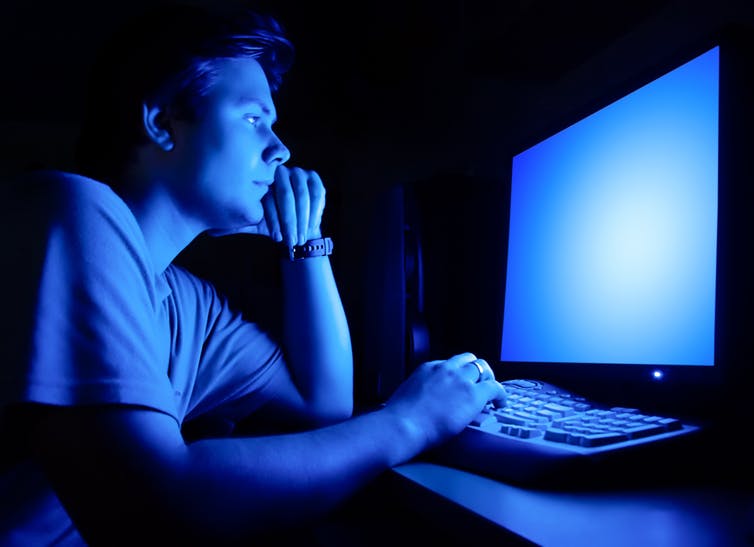by Joseph Giandonato, PhD-c, MBA, MS, CSCS
While the proliferation of technology, particularly advances in nanotechnology have facilitated improved ability to connect, monitor, and analyze, the blade on the other end of its proverbial double-edged sword is accompanied by numerous collateral impacts on health.
Seemingly innocuous, smart phones, tablets, TVs, and laptops are relied upon as pre-bedtime staples — go-tos to unwind after a long day which for corporatized Americans, ironically consists of screentime — an average of seven hours daily to be exact (AOA, 2024). But these devices, repurposed for nighttime entertainment rituals and decompression following a hectic day, can adversely impact sleep.
Disordered sleep is becoming as American as obesity and automotive engineering blunders like the abominably styled and highly combustible Ford Pinto and practically anything manufactured by Mopar.
The data shows that 50 to 70 million Americans suffer from a sleep disorder (NIH, 2023), characterized by a cluster of conditions interfering with normal sleep patterns. Further, 1 in 3 Americans are affected by interrupted sleep (NIH, 2023), which has been shown to acutely impact cognitive performance and work capacity and potentiate risk of developing mental health conditions and cardiometabolic disease (Chattu et al., 2018). Sleep disorders also account for nearly $100 billion dollars in annual health care expenditures within the US (Mass Eye and Ear, 2021) with untold billions more lost via reduced productivity and absenteeism each year.
Interrupted sleep impacts sleep quality, which in recent years has been touted as being more seminal to health outcomes, even more so than sleep duration and its long-championed gold standard of 7 to 9 hours that has been promulgated by health organizations for eternity.
Sleep quality is inclusive of sleep continuity and efficiency, two facets that are attained by fewer disruptions and protracted periods of deeper, restorative rapid eye movement (REM) sleep. REM sleep is linked to emotional processing, brain development, and memory consolidation, a neurophysiological phenomenon entailing the conversion of temporary labile memories in the hippocampus to imprinted ones amid regions of the neocortex. In essence, REM sleep is the hot summer sun which “cements” the freshly poured concrete of transient memories.
But sleep quality is often hemorrhaged by modern society. A society that is predicated on connectivity and chasing dopamine highs via handheld devices and screens. Handheld devices and screens, specifically the blue light they emit, have been implicated in diminishing sleep quality per a recent systematic review conducted by Silvani and colleagues (2022). One-fifth of the studies meeting inclusion criteria for the review reported a decrease in sleep quality which could plausibly impact performance in multiple contexts — occupational, scholastic, and athletic performance.
Blue light is a form of artificial light and encompasses light-emitting diodes (LEDs). As such it possesses a vastly different spectral distribution than sunlight characterized by shorter wavelengths that have been shown to incite corneal and retinal inflammation following protracted exposure and in response to short bursts at higher wavelengths (Zhao et al., 2018).
Blue light exposure also has been shown to impart effects on intrinsically photosensitive retinal ganglion cells (ipRGCs), in turn inhibiting pineal gland function, specifically influencing the release of melatonin.
A more recent investigation by Suardiaz-Muro and colleagues (2023) hypothesized that sleep quality is positively related to academic performance and that being a good sleeper (categorized by a score greater or equal to 5 on the Pittsburgh Sleep Quality Index (PSQI). To explore these hypothesized relationships, the researchers employed a descriptive, cross-sectional, and correlational study in which university students (n=640) across five academic departments in a major public research university in their first three years of academic study, were chosen at random as subjects. Students who were employed at the same time while engaged in academic study were excluded from the study as subjects. Variables such as sociodemographic characteristics (e.g., age and sex), anthropometric data, course and shift class schedule, sleep habits, sleep dept, or the discrepancy between self-reported ideal sleep time and real sleep time, sleep quality via the PSQI, daytime sleepiness, stimulant consumption, and academic performance via a Likert-type battery were collected.
To homogenize the sample and reduce selection biases, inclusion and exclusion criteria was determined for subjects. Analyses were performed by grouping categories of the dependent variable into “poor”, “normal”, and “good. Statistical analyses constituted frequencies and percentages to describe categorical variables as well as Pearson’s and adjusted standardized residuals for comparisons. Quantitative variables were explicated by means and standard deviations with comparisons among groups employing t-tests and ANOVA with Bonferroni corrections. Statistical significance was set to an alpha level of 5% (p< 0.05).
Significant differences in sleep quality were noted among the three academic performance groups and higher overall scores on the PSQI, indicating worse sleep quality was correlated with worse academic performance. Sleep quality components were established as key determinants of academic performance as high mean frequencies were noted among subjective sleep quality (F=19.03) and sleep efficiency (F=10.64) across all groups.
Technology usage among students is widespread and a recent survey involving technology usage patterns revealed considerable use of computers and smart phones prior to bedtime (Pham et al., 2021). These observations were echoed in a later investigation — a cross-sectional survey consisting of over 10,000 adults, of which nearly 40% reported poor sleep quality (AlShareef, 2022). Nearly all survey respondents reported having a smartphone in their bedrooms which were used regularly prior to sleep.
So, what can be done to remove the blue illuminated elephant in the room that is blocking the path to improved sleep?
Well for starters, inculcating some simple and sustainable habits, such as downloading a dimming application for your smartphone, tablet, or laptop that will alter the hue of the light to a rosier shade or automatically reduce the brightness. Additionally, blue light exposure can be minimized by switching from a white background to a black background within settings. But most importantly, screen time, specifically prior to bedtime should be relegated to critical purposes, such as being on call for work or needing to remain available for a loved one.
Otherwise, screentime should be ceased 30 to 60 minutes per day (Hale et al., 2018) and based on the findings from the aforementioned cross-sectional survey, phones should be kept outside of the bedroom, unless absolutely necessary. Other measures to improve sleep quality include harmonizing the sleep microclimate of bedding, clothing, and ambient temperature and humidity, refraining from consuming large meals prior to bedtime, especially comprised of faster digesting foods (e.g., carbohydrates and fiber), and avoiding the ingestion of large quantities of fluid prior to bedtime.
In conclusion, sleep quality is a critically important aspect of health and based on the literature, predictive of both acute performance and health outcomes. Therefore, it is imperative that the role of sleep quality is not overlooked by the medical community and instead prioritized by practitioners, educators, and organizations to ensure the health of the population they serve.
References
AlShareef, S. M. (2022). The impact of bedtime technology use on sleep quality and excessive daytime sleepiness in adults. Sleep Science, 15(S 02), 318–327. https://doi.org/10.5935/1984-0063.20200128
Chattu, V. K., Manzar, M. D., Kumary, S., Burman, D., Spence, D. W., & Pandi-Perumal, S. R. (2018). The global problem of insufficient sleep and its serious public health implications. Healthcare, 7(1), 1. https://doi.org/10.3390/healthcare7010001
Hale, L., Kirschen, G. W., LeBourgeois, M. K., Gradisar, M., Garrison, M. M., Montgomery-Downs, H., Kirschen, H., McHale, S. M., Chang, A., & Buxton, O. M. (2018). Youth screen media habits and sleep. Child and Adolescent Psychiatric Clinics of North America, 27(2), 229–245. https://doi.org/10.1016/j.chc.2017.11.014
New Report Reveals Cost of Unmanaged Screen Time Symptoms to be $151 billion per year. (2024, January 30). AOA. https://www.aoa.org/about-the-aoa/press-room/press-releases/new-report-reveals-cost-of-unmanaged-screen-time-symptoms-to-be-151-billion-per-year#:~:text=To%20understand%20the%20quantifiable%20impact,and%20wellbeing%20costs%20in%202023.
Pham, H. T., Chuang, H., Kuo, C., Yeh, T., & Liao, W. (2021). Electronic Device Use before Bedtime and Sleep Quality among University Students. Healthcare, 9(9), 1091. https://doi.org/10.3390/healthcare9091091
Silvani, M. I., Werder, R., & Perret, C. (2022). The influence of blue light on sleep, performance and wellbeing in young adults: a systematic review. Frontiers in Physiology, 13. https://doi.org/10.3389/fphys.2022.943108
Sleep disorders tally $94.9 billion in health care costs each year. (2021, May 7). Mass Eye and Ear. https://masseyeandear.org/news/press-releases/2021/05/sleep-disorders-tally-94-billion-in-health-care-costs-each-year
Suardiaz-Muro, M., Ortega-Moreno, M., Morante-Ruiz, M., Monroy, M., Ruiz, M. A., Martín-Plasencia, P., & Vela-Bueno, A. (2023). Sleep quality and sleep deprivation: relationship with
academic performance in university students during examination period. Sleep and Biological Rhythms, 21(3), 377–383. https://doi.org/10.1007/s41105-023-00457-1
Sleep Health | NHLBI, NIH. (2023, July 26). NHLBI, NIH. https://www.nhlbi.nih.gov/health-topics/education-and-awareness/sleep-health
Zhao, Z., Zhou, Y., Tan, G., & Li, J. (2018). Research progress about the effect and prevention of blue light on eyes. International Journal of Ophthalmology, 11(12), 1999-2003. https://doi.org/10.18240/ijo.2018.12.20


Leave a Reply